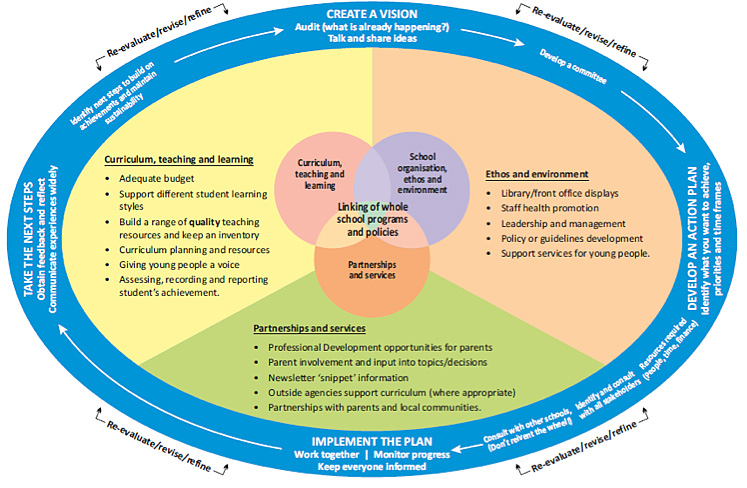A Model for Health and Wellbeing.

Diagram 1 shows examples of the components of a Health Promoting Schools Framework.
Acknowledgement to Cancer Council Western Australia
Why become a Health Promoting School?
Young people today grow up in an environment that increasingly encourages negative risk-taking behaviour through negative role models, peer influence, ambiguous role expectations and social /media influence amongst other factors. Young people develop these risk behaviours in varying degrees which may impede their educational progress. For young people, education and health are inextricably connected; therefore efforts to improve school performance also need to include improving the health status of children and adolescents.
The most serious and threatening health problems in society today relate primarily to personal decision-making and lifestyle. The behaviours and lifestyles that lead to these preventable health problems are almost always developed and/or sustained during the early years of life, especially school years.
The school is uniquely placed to respond to students’ basic needs for health education. After the home, the school has the greatest capacity to intervene to benefit each student. Research indicates that healthier students are better learners. 6. Intervention strategies within the school are effective in reducing a number of risk behaviours as well as reinforcing and maintaining positive health behaviours for most students. 3.
Getting Started toward a Health Promoting School
Whether you already have ideas of what your school needs or if you do not have a certain focus area and would like to create one, here are a few tips to consider when establishing your Health Promoting School.
- Raise the issue
- Advocate, create a need for comprehensive health education
- Talk to interested staff and parents to gain their support
- Gain the full support and commitment of the Principal and senior management team
- Have a health committee and nominated focus areas identified on the school development plan
- Nominate a health committee coordinator
- Form a health committee to help raise the profile and to enlist help and support. The committee should include teachers, non-teaching staff, students, parents and community members
- Conduct an audit of current health promoting actions. What is the school currently doing regarding healthy school policies, the school’s physical environment, the school’s social environment, individual health skills, community links and health services? The purpose of the audit is to determine what your school is currently doing well and if there are any gaps or areas of development that need to be addressed in the area you have identified as a need
- Share the results of the audit with the school community to determine what gaps need to be addressed
- Plan outcomes and actions. Consider what outcomes you wish to achieve
- Establish agreed goals and strategies to achieve them
- Implement change
- Monitor the progress of the changes
- Review
- Report on outcomes achieved and celebrate milestones. 4.
Further information to support schools (developed as part of the Western Australian Healthy Schools Project) is available here.
School Drug Education and Road Aware (SDERA). Provides a model to support a Health Promoting School. Diagram 2 outlines the process that schools can undertake to identify needs, develop actions and implement changes. The process and elements of the CHAT Model guide the way schools develop and implement an effective whole school approach. 7.
Diagram 2: CHAT: Changing Health Acting Together

Who can help?
There are many organisations that are available within the community that can support the Health Promoting School community. For a comprehensive list of organisations that may be able to assist in developing a Health Promoting School consider the WA Health Promoting Schools Association Inc. member agencies included on this site. www.wahpsa.org.au


